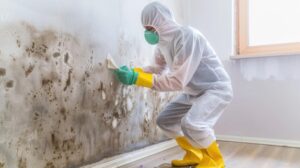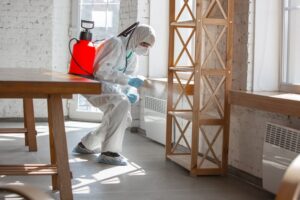
Wondering How Much Alternaria mold Will Cost? Find Out Here
Wondering how much it costs to remove Alternaria mold? Discover the factors that affect mold removal prices and get a clear idea of what to expect!
Alternaria Mold Cost |
| Average Cost | $3,750 |
| Highest Cost | $6,000 |
| Lowest Cost | $1,500 |
Introduction to Alternaria Mold
What is Alternaria Mold?
In Fort Myers, FL, Alternaria is a type of mold commonly found in damp environments like bathrooms, kitchens, and basements. It appears dark green or gray and thrives on organic materials such as wood, carpets, and fabrics.
Because Alternaria spreads rapidly in humid conditions typical of the area, addressing moisture issues promptly is essential to avoid higher Alternaria mold removal costs.
How Alternaria Mold Forms
In Fort Myers, FL, Alternaria mold thrives in damp, humid environments, especially in areas with poor ventilation. Its growth impacts Alternaria mold cost factors, as addressing these issues involves identifying moisture sources and remediation steps. Mold forms when moisture accumulates on organic materials like wood, carpets, and fabrics.
The cost of Alternaria mold removal in Fort Myers can increase due to factors like leaky pipes, high humidity, or water damage. Preventing costly treatments requires regular checks for moisture buildup and addressing conditions that encourage mold formation.
Health Risks of Alternaria Mold
Exposure to Alternaria mold can lead to allergic reactions, respiratory issues, and asthma symptoms. It may also cause skin irritation in some individuals, making it important to address mold growth as soon as it’s identified.
Alternaria Mold Removal Cost VS Other types of molds
Removal Cost
| Mold Type | Cost Range | Details |
| Black Mold Removal Cost | $2,000 – $10,000 | Toxic mold with significant health risks, often requires extensive removal. |
| Alternaria mold Removal Cost | $1,500 – $6,000 | Common indoor mold is found on fabrics, walls, and carpets. |
| Cladosporium mold Removal Cost | $1,000 – $5,000 | Non-toxic but can cause allergic reactions; thrives on damp wood or fabrics. |
| Penicillium mold Removal Cost | $1,000 – $4,000 | Known for spreading quickly; often found in water-damaged buildings. |
| Aspergillus mold Removal Cost | $500 – $4,000 | Common household mold; can cause irritation and allergic responses. |
| Fusarium mold Removal Cost | $1,500 – $6,500 | Found on water-damaged materials, poses health risks to respiratory systems. |
| Toxigenic Mold Removal Cost | $3,000 – $10,000+ | Produces mycotoxins; removal requires specialized treatments. |
| Outdoor Mold Removal Cost | $500 – $3,000 | Found on external structures; removal focuses on environmental control. |
| Common Indoor Mold Removal Cost | $1,000 – $4,500 | Includes various non-toxic molds causing mild allergic reactions. |
Factors Influencing Alternaria Mold Removal Costs
Extent of Infestation
Larger, widespread mold infestations require more labor and materials, increasing costs.
Location of Mold:Mold found in hard-to-reach areas, such as within walls or HVAC systems, adds complexity, raising both mold damage costs and Alternaria mold evaluation prices.
Property Size:Larger spaces take more time and resources to remediate effectively.
Type of Treatment:Advanced treatments like HEPA vacuuming, antimicrobial application, or structural repair can add to expenses.
Mold Testing Needs:Initial and post-remediation testing ensures safety but may increase overall costs.
Professional Expertise:Hiring certified mold removal professionals ensures quality but may cost more than DIY efforts.
Preventative Measures:Additional services, such as waterproofing or dehumidifier installation, contribute to long-term mold prevention but raise upfront costs.
Steps Involved in Alternaria Mold Removal

Inspection and Assessment
In Professional Mold Removal, experts thoroughly examine the property, identifying mold growth and moisture sources like leaks or poor ventilation. Precision tools, such as moisture meters, enhance accuracy.
Containment:Affected areas are sealed using plastic sheeting, negative air pressure, and HEPA filters to ensure that mold spores do not spread during remediation.
Mold Removal:Surfaces with visible mold are cleaned using appropriate methods like vacuuming with HEPA filters, scrubbing with antimicrobial solutions, or removing heavily contaminated materials such as drywall or carpeting.
Air Filtration and Cleaning:Advanced air purifiers are used to capture airborne spores. HVAC systems are inspected and cleaned if needed to avoid reinfestation.
Disinfection and Sanitization:Once the mold is removed, all surfaces are treated with mold-killing agents to ensure complete eradication and prevent regrowth.
Addressing Moisture Issues:Resolving moisture problems like leaks and improving ventilation is essential to prevent future mold growth, minimizing future mold removal contractors
Post-Remediation Inspection:A follow-up inspection confirms the successful removal of Alternaria mold and ensures the area meets safety standards for reoccupation.
Restoration:Replacing damaged materials like drywall or flooring restores the property’s condition. Restoration can contribute to a higher mold damage cost but ensures long-term safety and value in home remediation.
Prevention: How to Avoid Future Alternaria Mold Growth
Control Humidity
Maintain indoor humidity levels below 50% using dehumidifiers and proper ventilation, especially in bathrooms, kitchens, and basements.
Fix Water Issues Promptly:Address leaks, water damage, and condensation issues immediately to prevent damp environments where mold thrives.
Improve Air Circulation:Use exhaust fans and open windows to enhance airflow, reducing moisture accumulation in confined spaces.
Clean Regularly:Keep surfaces clean and dry, especially in mold-prone areas. Regularly disinfect items like shower curtains, windowsills, and air conditioning units
Use Mold-Resistant Materials:Opt for mold-resistant paints and building materials in areas with high moisture exposure, such as bathrooms and basements.
Inspect HVAC Systems:Regularly maintain and clean air conditioning systems to avoid the spread of spores through ventilation.
Store Items Properly:Avoid storing items directly against walls or floors in damp areas, as this can trap moisture and encourage mold growth.
Conclusion
In Fort Myers, FL, addressing Alternaria mold effectively requires swift action, professional expertise, and preventative measures. From understanding the health risks to implementing long-term solutions, every step is vital to ensuring a mold-free environment.
By investing in proper removal and adopting strategies to prevent regrowth, Fort Myers homeowners can safeguard their homes and health. Remember, prompt attention to water issues and maintaining proper indoor conditions can significantly reduce mold risks.
FAQs
Alternaria is a common mold type found indoors and outdoors, often associated with damp or water-damaged areas.
Alternaria mold can cause respiratory problems, allergic reactions, and skin irritation, especially for individuals with allergies or asthma.
Costs depend on the extent of the infestation, property size, and the remediation methods required.
Small patches can be cleaned using proper safety measures, but professional help is recommended for larger infestations.
